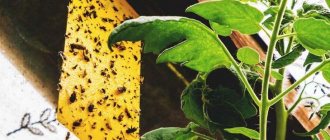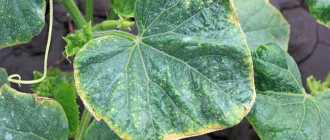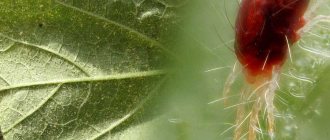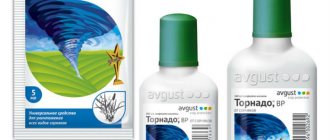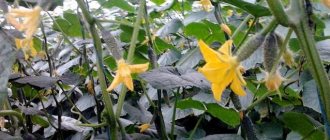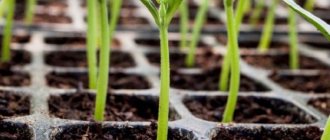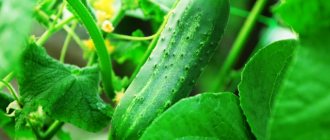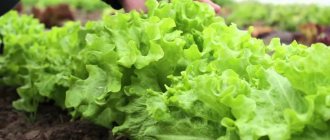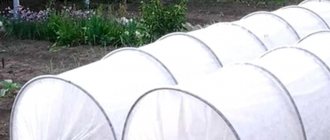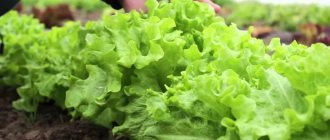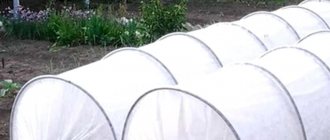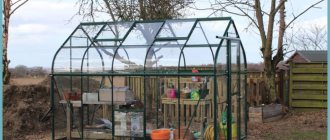The melon aphid often annoys gardeners. It affects cucumbers, pumpkins and zucchini in greenhouses and open ground, inhibits their growth and significantly reduces yield. It is important to begin combating aphids immediately after detection, as well as timely prevent the appearance of the pest. Methods for effectively getting rid of aphids on cucumbers in a greenhouse are described in this article.
How to fight aphids on cucumbers in a greenhouse
Aphids in the greenhouse: description of the pest
Melon aphids are small sucking insects of light yellow, green or black color ranging from 1.5 to 2.1 mm in size. They appear in greenhouses and greenhouses in May, attacking fresh vines of cucumbers and other crops. Colonies of pests stick to the back of leaves, young shoots and flowers. With severe damage, the leaves dry out, the plants wither and gradually die.
Aphids, adults, larvae and winged females
In greenhouse conditions, melon aphids reproduce quickly; they can produce up to 20 generations per season. If the fight is not started in time, it will fill the entire greenhouse and the crop will die. In addition to cucumbers, aphids can settle on other crops: tomatoes, eggplants, peppers and beans, and in some cases also on dill and carrots.
Aphids are dangerous not only because they suck juices from plants. The sticky secretions create a favorable environment for the development of fungus; in addition, the sweet coating disrupts plant respiration and photosynthesis. Adult aphids are capable of carrying more than 50 bacterial and viral diseases, the treatment of which will require disinfection of the greenhouse and replacement of the soil.
Fighting aphids
Identifying aphids is quite simple: the attached insects at first look like numerous pimples on the leaves and stems. Upon closer inspection, you can see not only adult individuals, but also larvae - smaller and almost colorless. Female aphids are viviparous; the development of the larvae takes no more than two weeks, after which the young individuals become capable of reproduction.
When the colony grows, winged individuals appear among the female aphids, capable of flying to other plants. Such females are distinguished by a darker body color and a pair of light long wings. In this phase of development of a pest colony, it is necessary to take urgent measures to destroy them immediately, otherwise the insects will completely colonize the area.
Life cycle of aphids
Garden ants play a major role in the spread of aphids throughout the garden. They feed on the sweet sticky juice secreted by adult aphids and take care of their “cash cows”: they transfer them to new plants and also shelter them in an anthill for overwintering. Therefore, the fight against aphids necessarily includes measures to get rid of ants.
Ants spread aphids
Important! In order to detect aphids on cucumbers in time, the plants must be inspected at least once a week. In addition to detecting the insects themselves, indirect signs of their appearance can be considered sticky spots on the leaves and a whitish coating on their underside.
Possible problems and errors
A problem when growing cucumbers and fighting aphids is the addition of fertilizers.
Systematic application of fertilizers increases the stability and resistance of vegetable crops and increases the ability to renew tissues. However, excessive addition of nitrogenous fertilizers has the opposite effect. Vegetable crops oversaturated with nitrates “get fat,” that is, they continuously form new leaves and shoots; young, succulent shoots unusually attract aphids.
Potassium-phosphorus fertilizers, on the contrary, make the leaves coarse and promote the production of nutrients in them that increase the osmotic pressure of cell sap, resulting in cucumbers becoming unattractive to sucking parasites.
It is important to remember that when choosing what to use to kill aphids that appear on cucumbers, they are based on the extent of the damage to the plantings. The use of powerful systemic poisons is justified only in cases of colossal damage to the vegetable crop by these pests. In all other situations, to clean plants, they are limited to the use of folk remedies and herbal decoctions. Of course, fighting aphids with such means is not as effective as treating them with pesticides, but in the early stages of infection of vegetable crops, folk remedies give excellent results.
Prevention of aphids
The appearance of pests in a greenhouse can be prevented by regular treatment of the soil and structures. Prevention includes a whole range of measures.
Greenhouse disinfection
Traditionally, the greenhouse is disinfected in the fall after the end of the season. Solutions for preventive treatment of greenhouses, as well as methods for their preparation and processing are given in Table 1.
Table 1. Solutions for preventive treatment of greenhouses.
| Name, illustrations | Description how to use |
| Copper sulfate | The powder is blue or turquoise in color; when diluted, it produces a solution of copper sulfate, which kills pest larvae, as well as fungal infections. Preparation of the solution: 1 tablespoon of powder is diluted in a liter of hot water, stirred thoroughly and brought to 10 liters with cold water. Water the soil with the solution until the top five-centimeter layer is moistened, and also spray the walls of the greenhouse and the fences of the beds. |
| Bordeaux mixture | It is a mixture of quicklime and copper sulfate, used for cultivating soil and greenhouse structures. Preparation of the solution: 100 g of copper sulfate powder is diluted in a liter of hot water, brought to 5 liters with cold water. In a separate bowl, quench 120 g of lime, after which the milk of lime is diluted with water to 5 liters. Carefully pour the vitriol into the lime solution with constant stirring. The solution is used immediately. The walls and frame of the greenhouse and the top layer of soil are treated from pests and bacteria. |
| Bleaching powder | The finished powder is white in color with a sharp, specific odor. Destroys adult aphids and larvae. The powder is scattered over the surface of the soil, after which the top layer is loosened to a depth of 5-8 cm. |
| Karbofos or fufanon | A chemical substance in the form of a solution is used to treat the soil to kill pests. Dilute a solution of karbofos (30 g per 10 liters) or fufanon (10 ml per 10 liters) in cold water, water the soil until moist. |
Important! Before processing, it is necessary to completely remove all tops and plant debris from the greenhouse - pests and larvae can hide in them.
Fighting ants
Ants often settle in greenhouses; this is facilitated by early warming of the soil and stable temperature. Ants grow aphids for their sweet juice (honeydew), for which they spread them to plants. It is pointless to remove aphids without destroying anthills - ants will quickly populate new larvae in place of destroyed insects.
Ants are fought using special means or traditional methods.
- The Anteater product is used to kill ants in the form of a solution that is used to water anthills. A 1 ml bottle of the drug is diluted in 3-5 liters of water and watered anthills in the morning or evening, when the ants are in the shelter. Within 2-3 days, the entire population of the anthill dies.
Ant-eater
Prices for the product "Aardeater"
anteater remedy
- The product “Grom-2” in the form of granules is scattered over the surface of the anthill, having first removed the top layer of it by 2-3 cm. The removed soil is scattered on top of the preparation. Within 2-4 days the ants die, the effect of the product lasts up to 2 months.
- Sprinkle anthills with ash, lime or baking soda, followed by watering with hot water. Penetrating into the passages, water with an alkaline reaction has a destructive effect on ant larvae and adults.
- Digging anthills to a depth of 25-35 cm allows you to completely destroy the nest. It is performed before planting cucumbers in the greenhouse and preparing the beds. Larvae and ants are scalded with boiling water when digging.
- Plants with a pungent odor are laid out on the beds - garlic, mint, oregano, valerian. They scare away the ants and force them to leave the greenhouse.
Valerian
Oregano
Mint
Garlic
Grom-2
The found anthill should be covered with ash, lime or ash.
Digging up an anthill
Important! When fighting ants, it is necessary to treat not only the soil inside the greenhouse, but also the areas adjacent to it.
Preventative treatments
To prevent the appearance of aphids, you can treat young plants with one of the biological products, for example, Fitoverm. This product does not have a harmful effect on plants or soil bacteria, and its waiting period is 2 days, after which its fruits can be eaten. Fitoverm can be used to treat plants in any phase of growth and fruiting.
Fitoverm
Dilute the drug in a dosage of 1 ampoule per 1.2 liters of water and spray the plants in the morning or evening until the leaves are moistened. Spraying for preventive purposes is sufficient to carry out once every 15-20 days, starting from planting until mid-July. During the summer period, 3 treatments are usually carried out.
Important! Fitoverm cannot be mixed with other drugs! Treatment must be carried out no earlier than 24 hours after foliar feeding and treatment with other means.
Prices for Fitoverm
fitoverm
Harm
The usual time for an aphid attack is the second half of summer, since the pest begins active reproduction in July. Located in colonies on the underside of cucumber leaves, melon aphids feed on sap (you can find out more about what aphids feed in nature here).
The bushes begin to lose strength, the leaves turn yellow and curl, and the growth of cucumbers slows down. Black aphids cause no less harm to cucumbers. The voracious family attacks almost all parts of the plant :
- stem;
- foliage;
- inflorescences;
- ripening fruits.
A young plant attacked by a colony of aphids is unable to develop and produce an ovary. Most of the cucumbers die.
Cucumbers suffer from aphid invasion not only in the open ground, but also in the greenhouse. The sugary juice (honeydew) secreted by insects glues cucumber leaves together and is a good bait for other garden pests.
Agrotechnical methods of combating aphids
Agrotechnical methods involve strengthening plant immunity and using environmentally friendly pest control methods. The effectiveness of these methods is quite high, especially if they are used in combination.
Types of aphids and their biological enemies: 1 - Aphid, 2 - Coniferous aphid, 3 - Phylloxera aphid, 4 - Apple aphid, 5 - Lacewing, 6 - Hemerobia, 8 - Decorated spherophoria, 9 - Bandaged sirph, 10 - Hoverfly , 11,12,13 - Cows, 14 - Orius bug, 15 - Zikrona bug, 16,17 - Aphelinus ichneumon
Attracting biological enemies
Adult aphids and larvae are happily eaten by predatory insects, and by attracting them to your greenhouse, you can reduce the number of pests without harming the plants.
Biological enemies of aphids include:
Ladybugs can be carefully collected from the garden or meadow and released into the greenhouse. They will take root and begin to lay larvae, which are unusually voracious: one ladybug larva can destroy up to a hundred aphids per day.
Ladybug destroys aphids
To attract predatory insects - hoverflies, lacewings and wasps - experienced gardeners recommend planting aromatic herbs along the beds in the greenhouse: dill, parsley, fennel and cilantro.
Common lacewing
Hoverfly
Earwigs feed on aphid larvae. They prefer warm and humid places as shelters; for this, you can pour piles of sawdust or bark in the greenhouse and pour water on them.
Earwig
Birds eat winged aphids and prevent them from spreading throughout the garden. To attract birds to the greenhouse, you can hang feeders and place drinkers in advance, at the beginning of the season, so that the birds get used to it.
Sparrow
Planting bait plants
The melon aphid prefers to feed on young plants with tender leaves. This is the basis of the agrotechnical method of combating aphids by planting bait plants. As such plants, you can use beans, dill, as well as cucumber seedlings that are younger than the main plantings. Plants are planted along the ridges, and when pests appear, they are torn off and burned along with aphids.
Dill is planted along the cucumbers
Some weeds also attract aphids. These herbs include all types of thistle. It is enough to leave one or two sow thistle bushes near the cucumbers in the greenhouse, and a significant part of the aphids will end up on them. Infected parts of the plant are torn off along with the pests and destroyed. Thistle is good because it does not take away nutrients from plants, since its root goes to a considerable depth and takes nutrition from there, while the root system of the cucumber lies in the top layer of soil.
Bait plant - sow thistle
Important! To prevent the sow thistle from being seeded, it is important to pick off the flowers in time. There is no need to be afraid of vegetative propagation; sow thistle is a biennial plant, so after two seasons it will die on its own.
Planting repellent plants
Planting repellent plants, the smell of which aphids cannot stand, also has some effect.
These include:
- mustard;
- cilantro;
- mint;
- basil;
- marigold.
They are sown along the edges of cucumber beds or planted near the entrance. Mint also repels ants that spread aphids. Basil and marigolds repel, in addition to aphids, many other pests, including nematodes.
Marigolds repel aphids
Strengthening plant immunity
Another agrotechnical method to reduce the harmful effects of aphids on plants is strengthening the immune system. To do this, it is important to use healthy planting material, apply fertilizers on time and properly prepare the soil.
The temperature regime in the greenhouse also promotes the growth of healthy cucumbers: during the day the temperature should be within 25-30°C, at night – 15-18°C. An increase or decrease in temperature from these limits weakens the plants and they become susceptible to infection by infections carried by aphids.
Proper watering is of great importance. For it, it is necessary to use soft water with a temperature of about 25°C, and also maintain the humidity in the greenhouse within 70-80%. As a preventative measure, in the first half of summer you can use an infusion of nettle or tomato tops for watering. In addition to the repellent effect, this infusion enriches the soil with easily digestible nitrogen, which benefits cucumbers. Foliar feeding with complex fertilizer for melons and melons is also useful.
Watering cucumbers with warm water
Signs of defeat
Cucumber bushes infected with aphids look like this:
- leaves are faded, twisted, drooping;
- flowers and ovaries fall off;
- small insects are visible on the back of the leaf;
- The leaf blades on the back side are covered with a thin film of sticky aphid secretions.
As the number of colonies grows, insects colonize stems, buds, and young shoots.
Folk methods of struggle
If aphids have settled on cucumbers, you must immediately begin to fight them. While the colony is small, it is not necessary to use chemicals; you can get by with folk remedies. They do not kill the pest completely after the first treatment, but significantly weaken the larvae and repel adults. At the same time, traditional methods in the correct dosage do not have a harmful effect on the soil and plants.
Spraying with herbal infusions
Infusions of aromatic herbs repel aphids and their carriers - ants. The most popular solution recipes are given in Table 2.
Table 2. Traditional recipes for fighting aphids
| Name, illustrations | How to use it correctly |
| Onion peel | Half a bucket of husks is brewed with boiling water, left for 24 hours, filtered, and brought to a volume of 10 liters with water. This solution is sprayed on cucumbers and the soil underneath them. |
| Hot pepper | Pour 1 kg of hot pepper into 3 liters of water and cook for about an hour. Infuse the decoction for at least two days and bottle it in dark glass or plastic. For processing, use half a glass of this infusion in half a bucket of water. You can also use dusting the leaves with ground red pepper. |
| Garlic | Three large heads of garlic are crushed, poured with a liter of water and put in a dark place for 4-5 days. For spraying, 2 tablespoons of infusion are diluted in 5 liters of water. |
| Celandine | Fill half a pan of fresh celandine with water, keep in a cool place for a day, then boil for 30 minutes. Strain the solution and bring it to a volume of 3 liters. |
| Yarrow | The dry herb is brewed in a thermos, left for two hours, after which the solution is diluted to a light brown color and sprayed on the cucumbers. |
Important! It is better to carry out the treatment in the evening or in the morning, since in the bright sun the effect of the solution may change. You need to wet both sides of the leaves, as well as the stems and flowers.
Treatment with soap solution
The soap solution itself repels aphids. It is also mixed with decoctions and infusions of herbs to enhance their effect: soap helps the infusion stick better to the plant.
Popular recipes:
- 1 piece of laundry soap per 5 liters of water;
- 100 grams of tar soap per 10 liters of water;
- 40 g of any soap and a glass of wood ash per 10 liters of water.
The soap is grated and diluted in hot water, after which it is cooled and sprayed on the plants. It is recommended to first boil the ash in a liter of water for 20 minutes. If the infection is severe, the leaves can be washed with a soapy solution using a soft sponge or brush, this will help remove the larvae.
Soap is grated
Washing with water jet
Aphids can be washed off using a jet of water. It is recommended to use a universal nozzle with adjustable pressure so as not to break the plants, but to remove pests. After washing the plants, sprinkle the soil under them with ash - this will help kill the washed away pests, but will not harm the cucumbers.
Video - Fighting aphids in a greenhouse using folk methods
How to treat a greenhouse against spider mites in the fall
You can find a list of effective remedies and step-by-step instructions for use in this article! We also recommend reading the article on how to fight whiteflies in a greenhouse.
Symptoms of infection
Most often, the provocateur of the appearance and reproduction of these pests on the site is the gardener himself, thickening the beds or greenhouses, not removing weeds in a timely manner, ignoring the appearance of a large number of ants.
You can recognize a pest attack on cucumbers by the following signs:
- the growth and development of the plant stops, internodes are shortened;
- the activity of flowering and fruiting decreases, the ovaries fall off;
- cucumber leaves begin to curl, the lower ones wither;
- sticky drops (honey dew) appear on the foliage and stems - a waste product of insects;
- the tops of the main stem and lateral branches are deformed;
- Ants appear around the cucumber plot.
Related article:
Garden ants: what are the benefits and harms?
If you notice one or more of the listed symptoms, you should immediately examine the cucumbers. Aphids are located on the underside of leaves, sometimes crawl onto trunks, and make their way into buds. Rarely occurs on fruits. The choice of spraying agent for the plant depends on the intensity of the infection.
Even if it is impossible to save the plantings, treatment will have to be carried out. Affected plants are removed from the site, burned outside, and the soil is sprayed with insecticides.
Chemical methods of controlling aphids
It is recommended to use chemicals in case of severe infection, when traditional and agricultural methods no longer help. It is very important to observe the dosage and waiting period before harvesting, otherwise you can be poisoned by chemicals.
Treatment with herbal remedies
Herbal medicines include products made from plant materials. They are harmless to plants, beneficial insects, birds and humans. The waiting time before harvesting fruits from herbal remedies does not exceed 2-3 days.
The components contained in these preparations have an intestinal and contact effect on aphids and paralyze the nervous system. As a result, adults stop feeding and die within a few days. Repeated treatments are necessary to kill new generations of pests.
Fitoverm is a biological product based on 4th generation soil microorganisms. Sold as an emulsion in ampoules or vials. To combat aphids, use a solution in a dosage of 4-6 ml of Fitoverm per 1 liter of water. Treatments are carried out on the leaves in cloudy weather or in the evening until complete wetting. Do not wash off the preparation from the leaves for a week - during this period, the death of pests continues. Treatments are carried out three times per season with an interval of 15 days.
Fitoverm against aphids
Actofit is a drug based on aversectin, a yellow, transparent liquid. Dilute the drug in a dosage of 8 ml per 1 liter of water, spray the cucumbers on the leaves until wet, do not wash off for 8-10 hours. The frequency of aphid treatments is no more than two per season. The waiting period is 2 days.
Actofit - insecticide
Acarin or agravertin is a remedy for harmful insects, the base is an alcohol extract from the soil fungus streptomyces. The drug is diluted in a dosage of 6 ml per 1 liter of water and sprayed on the plants at least 24 hours after watering. The maximum effect is achieved when processed in hot weather at temperatures above 25°C. After spraying, do not water the cucumbers for 24 hours - this enhances the effect of the drug. One treatment is enough to kill an aphid colony.
Akarin
Note! For better adhesion of drugs to the leaves, you can add 1 teaspoon of any liquid detergent to the prepared solution.
Prices for Akarin
akarin
Spraying and treating soil with insecticides
If herbal medicines do not help, and aphids continue to plague cucumbers, you have to resort to strong chemicals. The list of these tools is quite wide; the diagram shown in the figure will help you understand them.
Chemical insecticides
All chemicals are divided into several groups based on their principle of action:
- contact insecticides;
- systemic insecticides;
- organophosphate insecticides.
Contact-acting preparations cause poisoning in aphids when they eat treated leaves, and also have an effect when applied directly to adults and larvae. Therefore, when spraying contact insecticides, it is necessary to completely wet all affected plants on both sides of the leaf.
Systemic insecticides, in addition to contact action, are able to be absorbed into plants when watered at the root. In this case, the juice entering the leaves acquires poisonous properties. Aphids receive a dose of insecticide when they feed, even if the drug does not fall directly on that part of the plant. This property of systemic drugs simplifies processing and guarantees effect.
Organophosphorus preparations are used primarily to control soil pests; however, the active substance can also have an effect on aphids due to absorption by plant roots and distribution through leaves and stems with sap.
The most effective are mixed preparations containing several toxic components. With their help, you can quickly get rid of aphids even with severely infested plants.
Spraying plants with chemicals
Fumigation with a sulfur bomb
An extreme measure to get rid of aphids in a greenhouse when all other methods have not produced a significant effect. Popular sulfur bombs for fumigating greenhouses in the fall: Climate, FAS, Pawn.
Sulfur checker
With their help, you can guarantee the destruction of adult individuals and larvae of aphids, as well as ants that carry them, and other harmful insects. This is where the advantages of the method end.
Disadvantages of using sulfur bombs:
- harmful effects on soil microorganisms, and, as a result, a blow to its fertility;
- after using the checker, severe corrosion of unprotected metal parts begins;
- The sulfur bomb cannot be used during plant growth and fruiting; it is used only after the end of the season.
To fumigate a greenhouse during the growing season of plants, you can use tobacco checkers, for example, a Hephaestus checker. When burned, it emits tobacco smoke, which, due to the nicotine it contains, inhibits and kills insect pests. This method has no harmful effect on plants.
Checker Hephaestus
Kinds
Cucumbers are a favorite treat for several types of aphids:
- The melon aphid especially loves them. The pest has a green color: it is difficult to immediately notice on cucumber leaves and stems.
- Other types of parasite that infect cucumbers are united by one name - black aphid.
The color of these pests varies from dark green to brown. Aphids prefer amino acids and carbohydrates contained in all parts of the bush and sap.
You can learn more about different types of aphids in this material.
Answers to popular questions
How to understand that a plant is affected by aphids?
The cucumber bush on which aphids have appeared fades and gets sick. The plant is covered with sticky honeydew, and small bugs can be seen on the back of the leaves.
What remedies are most effective against aphids – folk or chemical?
Products with a chemical composition act instantly, which means they help get rid of it faster. But they are more harmful compared to traditional and biological drugs. It is necessary to select a control method based on the degree of damage to cucumbers
Are there ways to get rid of aphids when cucumbers produce crops?
Folk remedies are used even when there are fruits on the cucumber bushes. After using biological preparations, you must wait 5 days before harvesting cucumbers.
Is it possible to prevent aphids from appearing in the garden?
If you start prevention in time, the risk of aphid penetration will be minimal.
